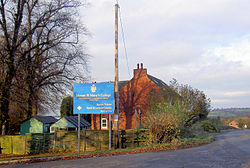Mount St Mary's College

Entrance to Mount St. Mary's College
|
|
| Motto | Sine Macula (Without Blemish) Ad Maiorem Dei Gloriam (For The Greater Glory of God) |
|---|---|
| Established | 1842 |
| Type |
Independent day with boarding |
| Religion | Roman Catholic, Jesuit |
| Headmaster | Dr Nicholas Cuddihy |
| Deputy Head Master | Mr Christopher McAllister & Mr Jack Murphy |
| Chairman of Governors | Fr Adrian Porter SJ |
| Founder | Fr Randal Lythgoe SJ |
| Location |
College Road Spinkhill, Derbyshire Derbyshire S21 3YL England Coordinates: 53°18′15″N 1°18′57″W / 53.3043°N 1.3158°W |
| DfE number | 830/6014 |
| DfE URN | 113010 Tables |
| Staff | Approx. 180 |
| Students | 350 |
| Gender | Coeducational |
| Ages | 11–18 |
| Houses | Campion, Xavier, Loyola |
| Colours | Red, Yellow, Green |
| Preparatory school | Barlborough Hall School |
| Former pupils | Old Mountaineers (OMs) |
| Registered Charity No. | 1117998 |
| Hours in school day | 8:30 am – 4:30 pm 5:45 pm leave optional for after school activities |
| Website | msmcollege |
Mount St Mary's College is an independent, coeducational, day and boarding school situated at Spinkhill, Derbyshire, near Sheffield, England. It was founded in 1842 as "The College of the Immaculate Conception at Spinkhill" by Fr Randal Lythgoe, the Provincial Superior of the Society of Jesus (better known as the Jesuits), and is still under the trusteeship of the Society. Although most teaching staff are lay members, the school still retains its Catholic ethos and values.
Its affiliated preparatory school is Barlborough Hall School, just 2.2 miles down the road.
The Jesuit mission to England began in 1580 with the secret arrival of Robert Persons, Edmund Campion, and Ralph Emerson. After Campion’s arrest the following year, Persons slipped back to the European mainland where he spent most of the rest of his life preparing others for the Jesuit mission to England. One of the first things he did was to set up a school for English boys who had no hope of receiving a Catholic education in their own country. Many of its students went on to become priests, returning to England to work and in some cases were killed when discovered by the authorities. In England, there were several clandestine schools, one of them was at Stanley Grange in Derbyshire. When this school was discovered and dispersed by the authorities, it did not cease to exist, it was moved to Spinkhill. Spinkhill had been a centre of Jesuit activity from the 1600s.
The Jesuit English Province was organised territorially into a number of "colleges", the North Midlands area being designated the college of the Immaculate Conception. In 1842 it was decided to found a school here in the hamlet of Spinkhill, a property of the Pole family, and that school was designated "The College of the Immaculate Conception at Spinkhill" after the nearby parish church. The founder of the college was Fr. Randall Lythgoe, S.J., Provincial of the Society of Jesus in England.
The college buildings date, in part, from the 16th and 17th centuries, the Sodality Chapel being the earliest remaining building. The Jesuits had a college at Holbeck Woodhouse, near Welbeck, which was raided by the soldiers of Charles II and the furnishings brought to Spinkhill. Joseph Hansom, an architect and inventor of the Hansom Cab, built the first college buildings in 1840. In 1850 the Hopkins wing (girls) was constructed. The new college was begun in 1876 and completed in 1912. The school chapel, designed by Adrian Gilbert Scott, was completed in 1924 as a memorial to former pupils killed in World War I. In the atrium to the chapel can be seen more than 100 names of former pupils of the school killed in the Second Boer War, World War I, and World War II.
...
Wikipedia
